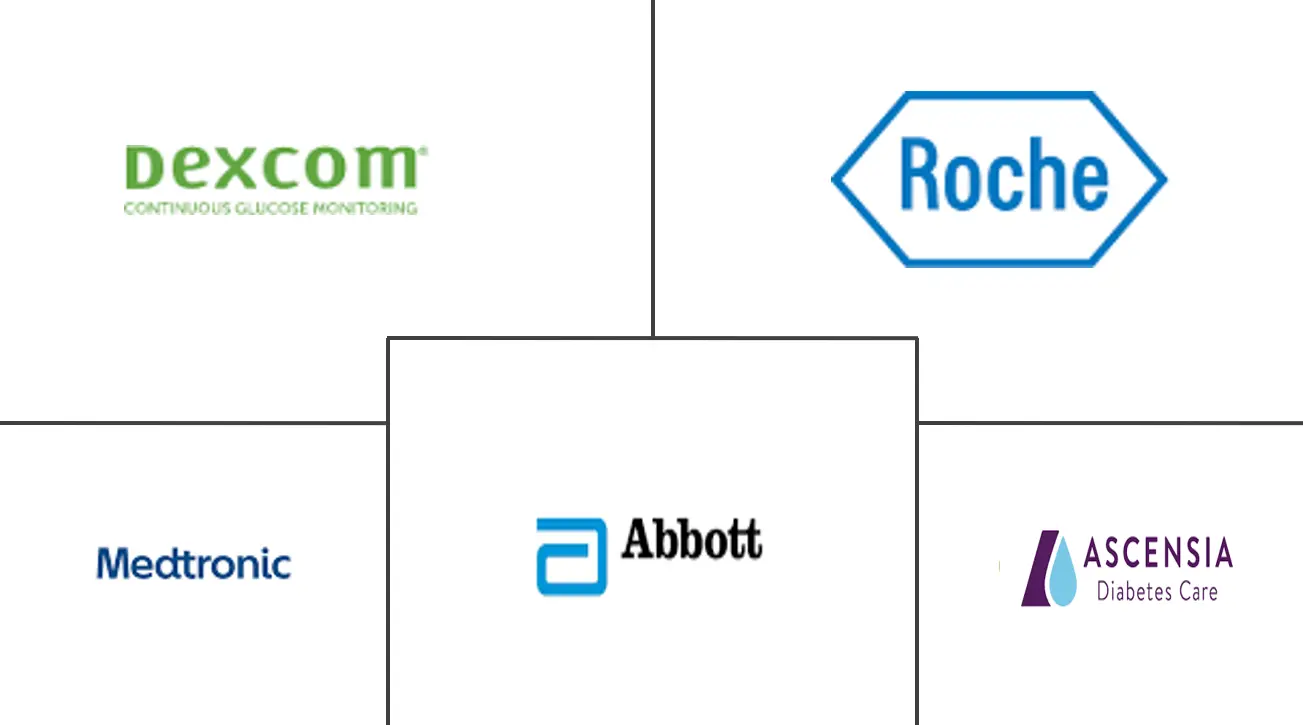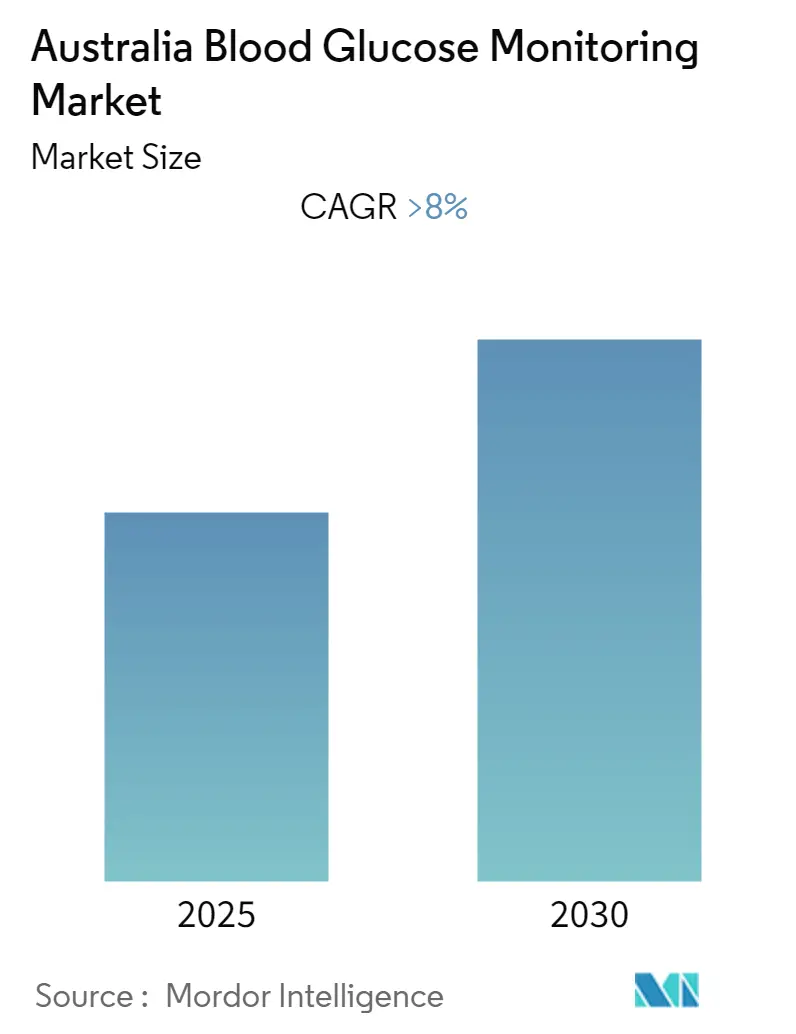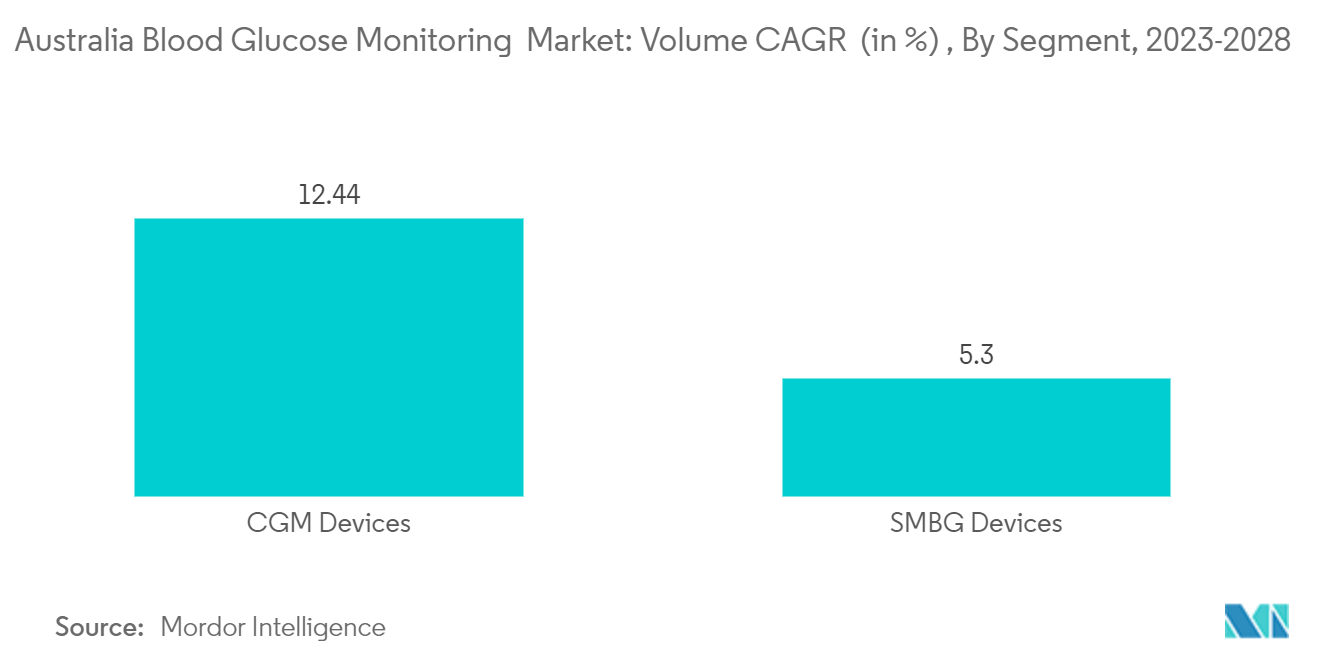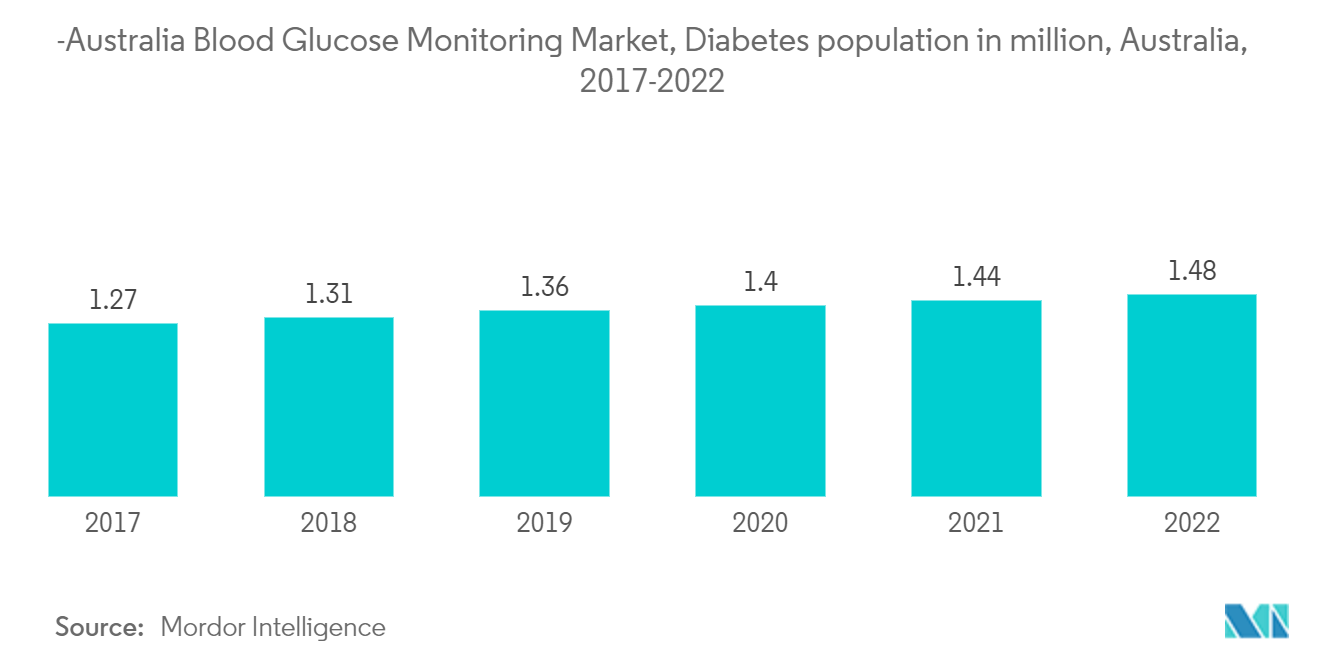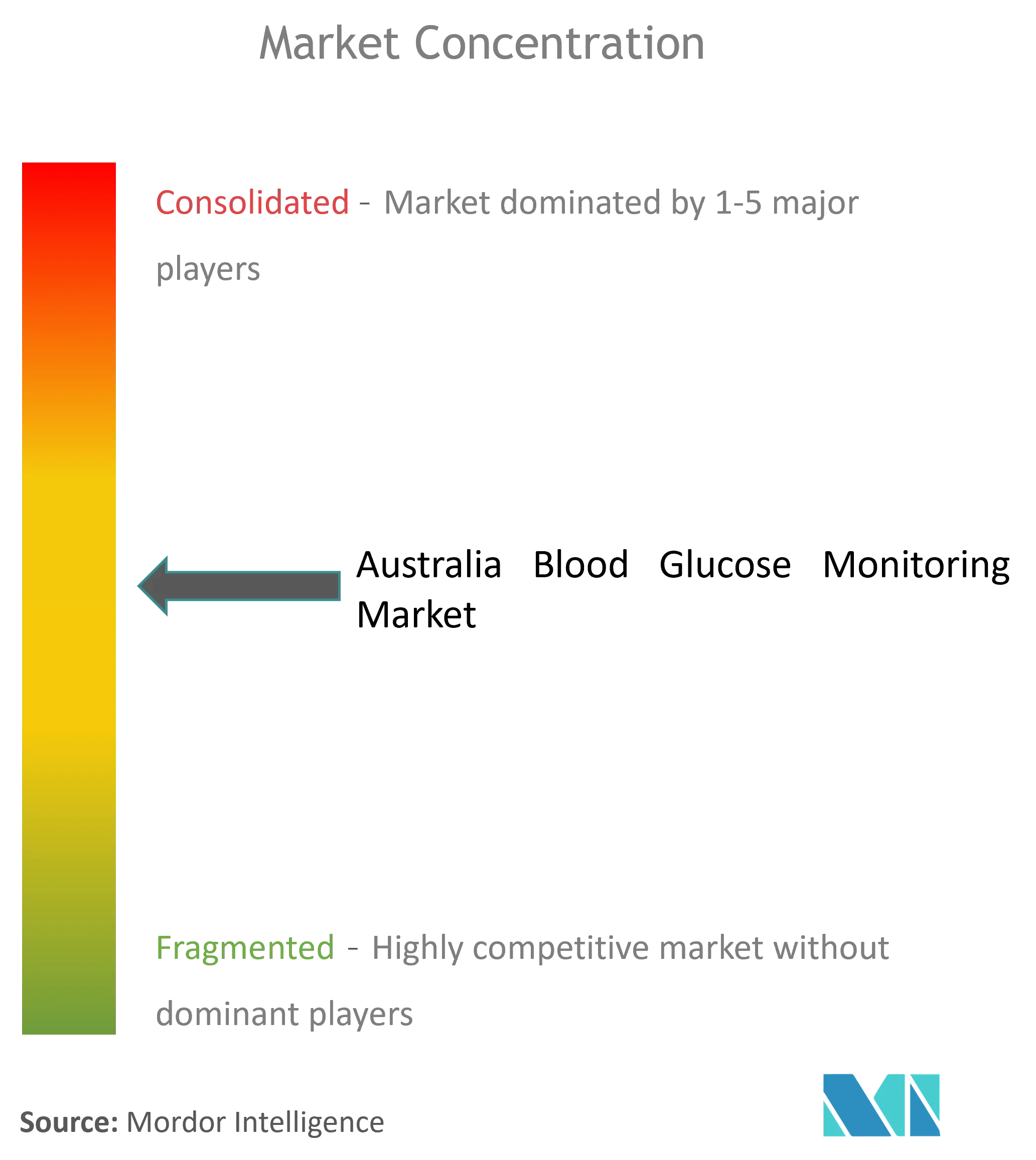Australia Blood Glucose Monitoring Market Analysis
The Australia Blood Glucose Monitoring Market is expected to register a CAGR of greater than 8% during the forecast period.
Diabetes mellitus was one of the most important risk factors for severe COVID-19. This risk was thought to be impacted by various diabetes-related characteristics, including advanced age, hyperglycemia, and underlying diseases (hypertension, cardiovascular disease, chronic renal disease, and obesity). Diabetes was soon identified as a risk factor for poor outcomes during the COVID-19 pandemic, making diabetes management or prevention more critical than ever. Following a COVID-19 infection, multiple investigations revealed that the afflicted individuals had fewer insulin secretory granules in beta cells and decreased glucose-stimulated insulin production. Furthermore, during the pandemic, some individuals acquired insulin resistance and had high blood glucose levels, although having no prior history of diabetes.
Blood glucose monitoring examines trends in blood glucose variation in response to nutrition, exercise, medicines, and disease processes related with blood glucose changes, such as diabetes. Blood glucose levels that are unusually high or low might result in acute and/or chronic, life-threatening diseases. Diabetes management that improves patient outcomes necessitates a multidisciplinary approach. Appropriate and prompt blood glucose monitoring enables successful control of out-of-range blood glucose levels, hence reducing diabetic-related health consequences.
Diabetes is linked to a slew of health issues. When comparing the populations with and without diabetes, persons with diabetes have a higher probability of being hospitalized and, as a result, incur more healthcare costs than non-diabetics. Diabetes patients are more likely to have significant consequences. Australia is a developed country with superior healthcare services. Continuous glucose monitoring is being implemented more quickly in Australia than in other emerging nations. Furthermore, reimbursement and price regulations are heavily controlled, driving the market and increasing the rate of adoption of new and sophisticated technology.
Australia Blood Glucose Monitoring Market Trends
The continuous glucose monitoring segment is expected to witness the highest growth rate over the forecast period.
Continuous glucose monitoring devices measure blood sugar levels using glucose oxidase. Glucose oxidase transforms glucose to hydrogen peroxidase, which combines with the platinum inside the sensor to provide an electrical signal that is sent to the transmitter. The most significant component of continuous glucose monitoring is the sensors. During the projected period, technological developments to increase sensor accuracy are likely to boost segment growth. Researchers are looking for and developing alternatives to electrochemical-based glucose sensors in order to build more inexpensive, less intrusive, and user-friendly CGM devices. Optical sensing is a potential platform for glucose detection. Some technologies, including spectroscopy, fluorescence, and holographic technology, have been found to offer considerable promise in continuous glucose sensing. Eversense, a CGM sensor invented by Senseonics Company that uses fluorescence detection, has a substantially longer lifespan than electrochemical sensors.
The regularity with which glucose levels are monitored is determined by the type of diabetes, which varies from patient to patient. Type 1 diabetics must check their blood glucose levels on a frequent basis in order to monitor their blood glucose levels and modify their insulin dose accordingly. Type-1 diabetic individuals spend roughly twice as much money on these devices as Type-2 diabetics. When compared to a routine check of glucose levels at fixed intervals, contemporary CGM systems provide a more complete picture of blood glucose patterns and trends. Furthermore, contemporary continuous glucose monitoring systems may either depict trends in blood glucose levels retrospectively by downloading data or provide a real-time image of glucose levels via receiver displays.
The increasing Diabetes Population in Australia is driving the market.
Between 1991 and 2022, the prevalence of diabetes in Australia more than doubled. Currently, Australia has over 2 million diabetic sufferers. According to Mordor Intelligence data, Type-2 diabetes patients made up the majority of the diabetic population in Australia this year. Nonetheless, diabetes is significantly more common in Australia than in many other countries. One of the most important aims of diabetes treatment is to keep blood glucose levels within a specified target range. It is possible to do this by balancing food, activity, lifestyle, and diabetes meds. The results of blood glucose monitoring provide the information required to determine the best diabetes management strategy. Maintaining target blood glucose levels can help reduce a person's risk of developing diabetes-related complications such as diabetic retinopathy and heart disease. Diabetes patients have blood glucose imbalances that do not correspond to traditional blood glucose levels. The basic lab diagnostic tests can only help doctors diagnose the disease. Patients whose glucose levels change more often should have them checked every day. Patients who take insulin must often evaluate their blood glucose levels and adjust insulin doses or change drugs as necessary. People with type 2 diabetes who do not take insulin require oral medications on a regular basis. In response to diabetes, the Australian National Diabetes Strategy was formed, which explained how current restricted healthcare resources across all levels of government might be efficiently integrated and targeted. This approach identifies the most successful and appropriate measures for reducing the community burden of diabetes and establishes the benchmark for future efforts.
Youth are more prone to get diabetes at a younger age due to the earlier age and longer diabetes duration, reducing their quality of life, shortening their life expectancy, and raising societal healthcare expenses. As a result, demand for diabetes care devices is increasing, as is their acceptance rate, boosting the market. Furthermore, with improved awareness among Type 2 diabetes patients, the need for Diabetes devices is developing rapidly.
Australia Blood Glucose Monitoring Industry Overview
Australia Blood Glucose Monitoring Market is moderately fragmented, with few significant and generic players. There have been constant innovations driven by manufacturers such as Abbott and Medtronic while also adhering to organic growth strategies, which is evident from the R&D spending of these companies.
Australia Blood Glucose Monitoring Market Leaders
-
Dexcom
-
Roche Diabetes Care
-
Abbott Diabetes Care
-
Ascensia Diabetes Care
-
Medtronics
- *Disclaimer: Major Players sorted in no particular order
Australia Blood Glucose Monitoring Market News
- January 2023: LifeScan announced that the peer-reviewed Journal of Diabetes Science and Technology published Improved Glycemic Control Using a Bluetooth Connected Blood Glucose Meter and a Mobile Diabetes App: Real-World Evidence From Over 144,000 People With Diabetes, detailing results from a retrospective analysis of real-world data from over 144,000 people with diabetes - one of the largest combined blood glucose meter and mobile diabetes app datasets ever published.
- January 2022: Roche launched its new point-of-care blood glucose monitor designed for hospital professionals, with a companion device shaped like a touchscreen smartphone that will run its own apps. The hand-held Cobas pulse includes an automated glucose test strip reader as well as a camera and touchscreen for logging other diagnostic results. It's designed to be used with patients of all ages, including neonates and people in intensive care.
Australia Blood Glucose Monitoring Industry Segmentation
Blood Glucose Monitoring Devices are used to diagnose both hyperglycemic and hypoglycemic conditions in diabetic patients. Australia Blood Glucose Monitoring Market is segmented into Type (Self-monitoring Blood Glucose Devices and Continuous Glucose Monitoring Devices), Component (Glucometer Devices, Test Strips, Lancets, Sensors, and Durables). The report offers the value (in USD million) and volume (in Units million) for the above segments.
| Self-Monitoring Blood Glucose Devices | Glucometer |
| Test Strips | |
| Lancets | |
| Continuous Glucose Monitoring Devices | Sensors |
| Durables (Receivers and Transmitters) |
Frequently Asked Questions
What is the current Australia Blood Glucose Monitoring Market size?
The Australia Blood Glucose Monitoring Market is projected to register a CAGR of greater than 8% during the forecast period (2025-2030)
Who are the key players in Australia Blood Glucose Monitoring Market?
Dexcom, Roche Diabetes Care, Abbott Diabetes Care, Ascensia Diabetes Care and Medtronics are the major companies operating in the Australia Blood Glucose Monitoring Market.
What years does this Australia Blood Glucose Monitoring Market cover?
The report covers the Australia Blood Glucose Monitoring Market historical market size for years: 2019, 2020, 2021, 2022, 2023 and 2024. The report also forecasts the Australia Blood Glucose Monitoring Market size for years: 2025, 2026, 2027, 2028, 2029 and 2030.
Our Best Selling Reports
Australia Blood Glucose Monitoring Industry Report
Statistics for the 2025 Australia Blood Glucose Monitoring market share, size and revenue growth rate, created by Mordor Intelligence™ Industry Reports. Australia Blood Glucose Monitoring analysis includes a market forecast outlook for 2025 to 2030 and historical overview. Get a sample of this industry analysis as a free report PDF download.

